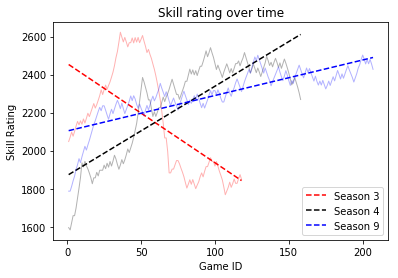Introduction
Game theory is a relatively new branch of mathematics that deals with strategic competitive situations where results are based on both the main participants and the other participants (competitors) actions. It’s application to multiplayer decision based games, like Overwatch, has been very interesting to many, including me. Multiple overwatch statisticians have taken to the internet to share their views on how Game theory and Overwatch intertwine.
Motivation
As an avid fan of Overwatch, and a new player of the recently released Overwatch 2, I thought it would be interesting to see how Game theory, which we will discuss in class in week 8, related to the competitive scene in Overwatch 1/2. Analysis will be done based of players strategic thinking, which also adds to my interest: I want to see why, statistically, my team chooses the hero’s they choose.
Analysis
A popular way of viewing Game Theory is through an example called the ‘Prisoners Dilemma’. This situation is one in which two criminals have been captured by the police, Bob and John. Bob and John have both been taken into separate interrogation rooms by two different police officers, both trying to get a confession out of the men. If John confesses, but Bob does not (lies about the crimes), John will get 0 years of prison, Bob getting 10, and vice-versa. If Bob and John both confess, they will both get 8 years. If neither confess (both lie about the crimes), they will both get only a single year. These outcomes are shown in the following diagram:

This dilemma can compare directly to Overwatch. Imagine Bob and John are your teammates, along with 2 more people, fighting the police (who’s numbers have also increased to 5). The dilemma can directly relate to choosing hero’s, and developing a team composition. If your teammates choose a proper team composition, their chance of winning the game increases substantially, symbolically related to both prisoners lying to the police. If your team does not choose a proper team composition (all damage characters for example), then your chance of winning the game decreases significantly.
One problem with the prisoners dilemma is that the prisoners, Bob and John in this case, don’t have the opportunity to communicate before-hand to agree on not confession (the most optimal case). This aspect of the prisoners dilemma is not reflected in Overwatch – teammates can actively communicate during the ‘interrogation’ (the match). The only difference is that avoiding jail is a much more substantial reward than winning a game of Overwatch. Sometimes, teammates can intentionally decide to not work as a team, prioritizing their own fun or spiting their teammates in a spur of toxicity to ruin their team’s chances of victory.
There is a concept in Game theory called the ‘Nash equilibrium’, which states that no one can increase their odds of success by changing their strategy while the other does not. In the prisoners dilemma example, either prisoners best move is to confess – if the other confesses, they only get 8 years (not 10), if the other does not, they will get 0 years. This is the Nash equilibrium of the prisoners dilemma – both prisoners should go through the interrogation with that strategy, they will gain nothing by changing it. The Nash equilibrium in Overwatch 1 was to choose a team composition of 2 tanks, 2 damage, and 2 support characters, also called 2-2-2. Unlike the prisoners dilemma, Overwatch is a live and changing game – the Nash equilibrium of Overwatch 1 changed with the introduction of a new meta called ‘Goats’, which was a 3 tank 3 support character composition. The old 2-2-2 Nash equilibrium was then forced by the developers of the game, as it was determined that the 3-3 team composition was ‘not fun’
Another factor in Overwatch’s Game theory is the player’s personal opinion on the game. Each player is a participant in Game theory, and thus, their personal lives and opinions of the game will affect their decisions and the results of the game. Specifically, if a player is on a losing/winning streak, they might be more inclined to choose a character that they prefer or think that they are good at, rather than one the team needs.

This is one specific players skill rating over time. As you can see, losses lead to more losses, wins lead to more wins. In a losing or winning streak, a player gain a toxic attitude towards the game (sick of losing or over-inflated ego from winning) and sabotage the Nash equilibrium by being selfish in their hero selection.
Conclusion
In conclusion, through Game Theory and Overwatch we can see that the Nash equilibrium of the game is a 2-2-2 composition, meaning 2 tanks, 2 healers, and 2 supports. In addition, the more a team works together and coordinates their actions against the team overall, the more likely they win.
References
Ho, S. (2022) Overwatch Data Visualization, Simon Ho. Available at: https://www.simonho.ca/gaming/overwatch-data-visualization/ (Accessed: October 27, 2022).
R/competitiveoverwatch – game theory and overwatch (no date) reddit. Available at: https://www.reddit.com/r/Competitiveoverwatch/comments/9ywf27/game_theory_and_overwatch/ (Accessed: October 27, 2022).